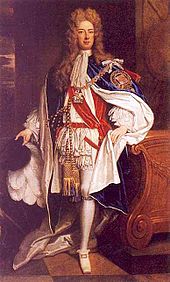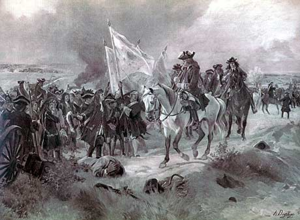Battle of Ramillies
| date | May 23, 1706 |
|---|---|
| place | Ramillies , today's Belgium |
| Casus Belli | Succession to the throne of Charles II of Spain |
| output | Allied victory |
| consequences | Conquest of the Spanish Netherlands by the Allies, withdrawal of the French and Bavaria |
| Peace treaty | Peace of Utrecht 1712 , Rastatt Peace 1714 , Peace of Baden 1714 |
| Parties to the conflict | |
|---|---|
|
|
|
| Commander | |
|
John Churchill, 1st Duke of Marlborough |
François de Neufville, duc de Villeroy |
| Troop strength | |
| 62,000 men | 60,000 men |
| losses | |
|
1,066 dead |
13,000 dead and wounded, |
Carpi - Chiari - Cremona - Kaiserswerth - Luzzara - Cádiz - Friedlingen - Vigo - Schmidmühlen - Ekeren - Höchstädt (1703) - Gibraltar - Speyerbach - Schellenberg - Bonn - Höchstädt (1704) - Vélez-Málaga - Cassano - Barcelona (1705) - Sendlinger Murder Christmas - Calcinato - Ramillies - Turin - Castiglione - Almansa - Toulon - Lille - Oudenaarde - Malplaquet - Almenara - Saragossa - Brihuega - Villaviciosa - Denain - Rio de Janeiro - Barcelona
The Battle of Ramillies was one of the most significant battles in the War of the Spanish Succession . On May 23, 1706, near the town of Ramillies (now in Belgium ), English and Dutch troops led by John Churchill, 1st Duke of Marlborough , defeated a French force. This victory forced the withdrawal of the French from the Spanish Netherlands , giving up the cities of Bruges , Antwerp and Ghent, and Habsburg secured the Spanish Netherlands.
Prehistory and course
After the great success at the Battle of Höchstädt in 1704, the year 1705 brought bitter disappointments for the Alliance. The French were well on their way to conquer all of Italy. Marlborough's original plan for 1706 to march from the Netherlands to Italy to support Prince Eugene of Savoy had to be discarded. The reason was an unexpected French offensive on the left bank of the Rhine.
Meanwhile, in their struggle against the French, the States General campaigned with the promise that they would send 10,000 men to support Prince Eugene in Italy to support Marlborough. Marlborough agreed and moved his troops near Liege to challenge French Marshal Villeroy to battle. Louis XIV was eager to undo the defeats suffered in 1704 and urged Villeroy to take action against Marlborough. The goal was to take back the fortress of Zoutleeuw ( fr. Léau ), which had been lost a year earlier. Villeroy sat at the head of an army of 60,000 men with 70 cannons. Marlborough concentrated its forces at Corswarem . The Anglo-Dutch-German army had a strength of over 62,000 men and 120 cannons. In the bloody four-hour fighting, the French army was put to flight, and the French moved towards the French border. The victorious Allies pursued the French and were able to recapture most of the Spanish Netherlands after the battle.

literature
- Winston Churchill : History, Vol. 3: The Age of Revolutions . Weltbild-Verlag, Augsburg 1990 (unchanged reprint of the Stuttgart edition 1957).
- Philippe de Courcillon, marquis de Dangeau: Journal de la cour du Roi-Soleil. Ramillies: 1706 , Paleo Éditeur 2009, ISBN 2-84909-463-3
- Théophile Lavallée: Histoire des Français depuis le temps des Gaulois jusqu'en 1830 - p. 384 ff. Dans l'édition Charpentier, 1856.
